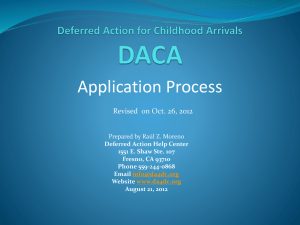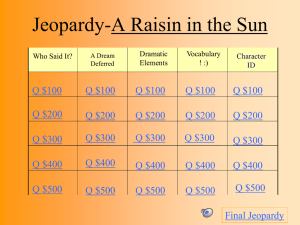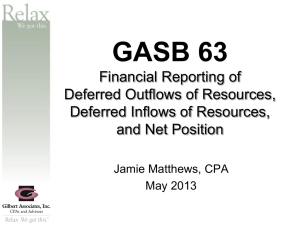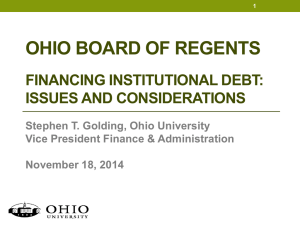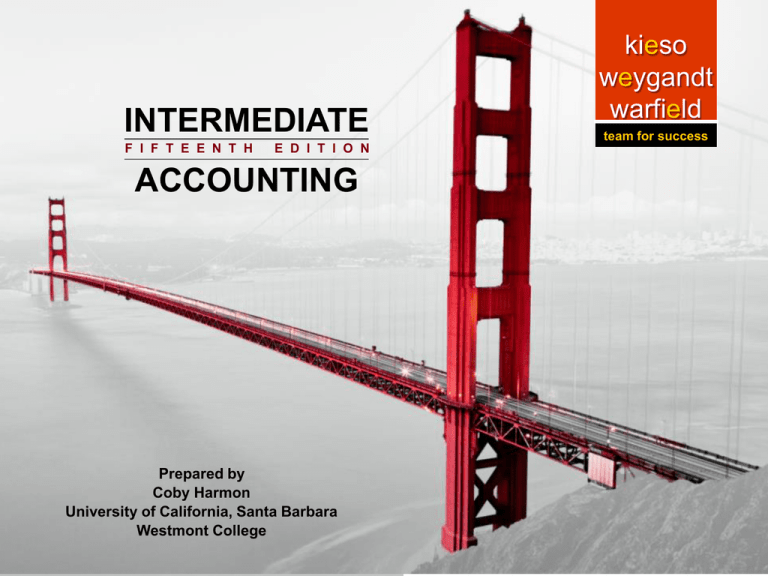
INTERMEDIATE
F I F T E E N T H
E D I T I O N
Intermediat
ACCOUNTING
Intermediat
e
e
Accounting
Accounting
Prepared by
Coby Harmon
Prepared by
University of California,
BarbaraPrepared by
CobySanta
Harmon
Harmon
Westmont
College SantaCoby
University
of California,
Barbara
University of California, Santa Barbara
19-1
Westmont College
kieso
weygandt
warfield
team for success
PREVIEW OF CHAPTER 19
Intermediate Accounting
15th Edition
Kieso Weygandt Warfield
19-2
19
Accounting for
Income Taxes
LEARNING OBJECTIVES
After studying this chapter, you should be able to:
1.
Identify differences between pretax
financial income and taxable income.
6.
Describe various temporary and
permanent differences.
2.
Describe a temporary difference that
results in future taxable amounts.
7.
3.
Describe a temporary difference that
results in future deductible amounts.
Explain the effect of various tax rates and
tax rate changes on deferred income
taxes.
8.
Explain the purpose of a deferred tax
asset valuation allowance.
Apply accounting procedures for a loss
carryback and a loss carryforward.
9.
Describe the presentation of deferred
income taxes in financial statements.
4.
5.
19-3
Describe the presentation of income tax
expense in the income statement.
10. Indicate the basic principles of the assetliability method.
Accounting for Income Taxes
Corporations must file income tax returns following the
guidelines developed by the Internal Revenue Service (IRS).
Because GAAP and tax regulations differ in a number of ways,
the amounts reported for the following will differ:
19-4
income tax expense (GAAP)
income tax payable (Internal Revenue Code).
LO 1
Accounting for Income Taxes
Financial Statements
Tax Return
vs.
Pretax Financial Income
GAAP
Income Tax Expense
19-5
Taxable Income
Tax Code
Income Taxes Payable
LO 1
Accounting for Income Taxes
Illustration: Chelsea, Inc. reported revenues of $130,000 and
expenses of $60,000 in each of its first three years of
operations. For tax purposes, Chelsea reported the same
expenses to the IRS in each of the years. Chelsea reported
taxable revenues of $100,000 in 2014, $150,000 in 2015, and
$140,000 in 2016. What is the effect on the accounts of
reporting different amounts of revenue for GAAP versus tax?
19-6
LO 1
Book vs. Tax Differences
Illustration 19-2
GAAP Reporting
2014
2015
2016
Total
Revenues
$130,000
$130,000
$130,000
$390,000
Expenses
60,000
60,000
60,000
180,000
Pretax financial income
$70,000
$70,000
$70,000
$210,000
Income tax expense (40%)
$28,000
$28,000
$28,000
$84,000
Illustration 19-3
Tax Reporting
2014
2015
2016
Total
Revenues
$100,000
$150,000
$140,000
$390,000
Expenses
60,000
60,000
60,000
180,000
Taxable income
$40,000
$90,000
$80,000
$210,000
Income tax payable (40%)
$16,000
$36,000
$32,000
$84,000
19-7
LO 1
Book vs. Tax Differences
Illustration 19-4
Comparison
2014
2015
2016
Total
Income tax expense (GAAP)
$28,000
$28,000
$28,000
$84,000
16,000
36,000
32,000
84,000
Difference
$12,000
$(8,000)
$(4,000)
Income tax expense (40%)
$28,000
$28,000
$28,000
$84,000
Are the differences accounted for in the financial statements?
Yes
Income tax payable (IRS)
Year
Reporting Requirement
2014
Deferred tax liability account increased to $12,000
2015
Deferred tax liability account reduced by $8,000
2016
Deferred tax liability account reduced by $4,000
19-8
$0
LO 1
Financial Reporting for 2014
Balance Sheet
Assets:
Income Statement
2014
2014
Revenues:
Expenses:
Liabilities:
Deferred taxes
12,000
Income taxes payable 16,000
Equity:
Income tax expense
28,000
Net income (loss)
Where does the “deferred tax liability” get reported in the financial
statements?
19-9
LO 1
19
Accounting for
Income Taxes
LEARNING OBJECTIVES
After studying this chapter, you should be able to:
1.
Identify differences between pretax
financial income and taxable income.
6.
Describe various temporary and
permanent differences.
2.
Describe a temporary difference that
results in future taxable amounts.
7.
3.
Describe a temporary difference that
results in future deductible amounts.
Explain the effect of various tax rates and
tax rate changes on deferred income
taxes.
8.
Explain the purpose of a deferred tax
asset valuation allowance.
Apply accounting procedures for a loss
carryback and a loss carryforward.
9.
Describe the presentation of deferred
income taxes in financial statements.
4.
5.
19-10
Describe the presentation of income tax
expense in the income statement.
10. Indicate the basic principles of the assetliability method.
Future Taxable and Deductible Amounts
A temporary difference is the difference between the tax basis of an
asset or liability and its reported (carrying or book) amount in the
financial statements that will result in taxable amounts or deductible
amounts in future years.
Future Taxable Amounts
Future Deductible Amounts
Deferred Tax Liability represents
the increase in taxes payable in
future years as a result of taxable
temporary differences existing at
the end of the current year.
Deferred Tax Asset represents the
increase in taxes refundable (or
saved) in future years as a result of
deductible temporary differences
existing at the end of the current
year.
Illustration 19-22 provides Examples of Temporary Differences
19-11
LO 2
Future Taxable Amounts
Illustration: In Chelsea’s situation, the only difference between
the book basis and tax basis of the assets and liabilities relates to
accounts receivable that arose from revenue recognized for book
purposes. Chelsea reports accounts receivable at $30,000 in the
December 31, 2014, GAAP-basis balance sheet. However, the
receivables have a zero tax basis.
Illustration 19-5
19-12
LO 2
Future Taxable Amounts
Illustration: Reversal of Temporary Difference, Chelsea Inc.
Illustration 19-6
Chelsea assumes that it will collect the accounts receivable and report
the $30,000 collection as taxable revenues in future tax returns.
Chelsea does this by recording a deferred tax liability.
19-13
LO 2
Deferred Taxes
Deferred Tax Liability
A deferred tax liability represents the increase in taxes payable
in future years as a result of taxable temporary differences
existing at the end of the current year.
Illustration 19-4
Income tax expense (GAAP)
Income tax payable (IRS)
Difference
19-14
2014
2015
2016
Total
$28,000
$28,000
$28,000
$84,000
16,000
36,000
32,000
84,000
$12,000
$(8,000)
$(4,000)
$0
LO 2
Deferred Tax Liability
Illustration: Because it is the first year of operations for Chelsea,
there is no deferred tax liability at the beginning of the year.
Chelsea computes the income tax expense for 2014 as follows:
Illustration 19-9
19-15
LO 2
Deferred Tax Liability
Illustration 19-9
Computation of Income
Tax Expense, 2014
Chelsea makes the following entry at the end of 2014 to record
income taxes.
Income Tax Expense
19-16
28,000
Income Taxes Payable
16,000
Deferred Tax Liability
12,000
LO 2
Deferred Tax Liability
Illustration 19-10
Computation of Income
Tax Expense for 2015
Chelsea makes the following entry at the end of 2015 to record
income taxes.
Income Tax Expense
28,000
Deferred Tax Liability
8,000
Income Taxes Payable
19-17
36,000
LO 2
Deferred Tax Liability
The entry to record income taxes at the end of 2016 reduces the
Deferred Tax Liability by $4,000. The Deferred Tax Liability account
appears as follows at the end of 2016.
Illustration 19-11
19-18
LO 2
19-19
LO 2
Deferred Tax Liability
Illustration: Starfleet Corporation has one temporary difference at
the end of 2014 that will reverse and cause taxable amounts of
$55,000 in 2015, $60,000 in 2016, and $75,000 in 2017. Starfleet’s
pretax financial income for 2014 is $400,000, and the tax rate is 30%
for all years. There are no deferred taxes at the beginning of 2014.
Instructions
a) Compute taxable income and income taxes payable for 2014.
b) Prepare the journal entry to record income tax expense,
deferred income taxes, and income taxes payable for 2014.
19-20
LO 2
Deferred Tax Liability
Illustration:
Current Yr.
INCOME:
2014
Financial income (GAAP)
400,000
Temporary Diff.
Taxable income (IRS)
b.
19-21
2016
2017
(190,000)
55,000
60,000
75,000
210,000
55,000
60,000
75,000
a.
Tax rate
Income tax
2015
30%
a.
Income Tax Expense (plug)
63,000
30%
16,500
30%
18,000
30%
22,500
120,000
Income Taxes Payable
63,000
Deferred Tax Liability
57,000
LO 2
19
Accounting for
Income Taxes
LEARNING OBJECTIVES
After studying this chapter, you should be able to:
1.
Identify differences between pretax
financial income and taxable income.
6.
Describe various temporary and
permanent differences.
2.
Describe a temporary difference that
results in future taxable amounts.
7.
3.
Describe a temporary difference that
results in future deductible amounts.
Explain the effect of various tax rates and
tax rate changes on deferred income
taxes.
8.
Explain the purpose of a deferred tax
asset valuation allowance.
Apply accounting procedures for a loss
carryback and a loss carryforward.
9.
Describe the presentation of deferred
income taxes in financial statements.
4.
5.
19-22
Describe the presentation of income tax
expense in the income statement.
10. Indicate the basic principles of the assetliability method.
Future Deductible Amounts
Illustration: During 2014, Cunningham Inc. estimated its warranty
costs related to the sale of microwave ovens to be $500,000, paid
evenly over the next two years. For book purposes, in 2014
Cunningham reported warranty expense and a related estimated
liability for warranties of $500,000 in its financial statements. For
tax purposes, the warranty tax deduction is not allowed until paid.
Illustration 19-12
19-23
LO 3
Future Deductible Amounts
Illustration: Reversal of Temporary Difference.
Illustration 19-13
2014
2015
2016
When Cunningham pays the warranty liability, it reports an expense
(deductible amount) for tax purposes. Cunningham reports this future
tax benefit in the December 31, 2014, balance sheet as a deferred tax
asset.
19-24
LO 3
Future Deductible Amounts
Deferred Tax Asset
A deferred tax asset represents the increase in taxes
refundable (or saved) in future years as a result of deductible
temporary differences existing at the end of the current year.
19-25
LO 3
Deferred Tax Asset
Illustration: Hunt Co. accrues a loss and a related liability of
$50,000 in 2014 for financial reporting purposes because of
pending litigation. Hunt cannot deduct this amount for tax purposes
until the period it pays the liability, expected in 2015.
Illustration 19-14
19-26
LO 3
Deferred Tax Asset
Assume that 2014 is Hunt’s first year of operations, and income tax
payable is $100,000, compute income tax expense.
Illustration 19-16
Prepare the entry at the end of 2014 to record income taxes.
Income Tax Expense
Deferred Tax Asset
Income Taxes Payable
19-27
80,000
20,000
100,000
LO 3
Deferred Tax Asset
Computation of Income Tax Expense for 2015.
Illustration 19-17
Prepare the entry at the end of 2015 to record income taxes.
Income Tax Expense
Deferred Tax Asset
Income Taxes Payable
19-28
160,000
20,000
140,000
LO 3
Deferred Tax Asset
The entry to record income taxes at the end of 2015 reduces the
Deferred Tax Asset by $20,000.
Illustration 19-18
19-29
LO 3
Deferred Tax Asset
Illustration: Columbia Corporation has one temporary difference at
the end of 2014 that will reverse and cause deductible amounts of
$50,000 in 2015, $65,000 in 2016, and $40,000 in 2017. Columbia’s
pretax financial income for 2014 is $200,000 and the tax rate is 34%
for all years. There are no deferred taxes at the beginning of 2014.
Columbia expects to be profitable in the future.
Instructions
a) Compute taxable income and income taxes payable for 2014.
b) Prepare the journal entry to record income tax expense, deferred
income taxes, and income taxes payable for 2014.
19-30
LO 3
Deferred Tax Asset
Illustration
Current Yr.
INCOME:
2014
Financial income (GAAP)
200,000
Temporary Diff.
Taxable income (IRS)
a.
Tax rate
Income tax
b.
2016
2017
155,000
(50,000)
(65,000)
(40,000)
355,000
(50,000)
(65,000)
(40,000)
34%
34%
34%
(17,000)
(22,100)
(13,600)
34%
a.
120,700
Income Tax Expense
68,000
Deferred Tax Asset
52,700
Income Taxes Payable
19-31
2015
Advance slide in presentation
mode to reveal answers.
120,700
LO 3
19-32
LO 3
19
Accounting for
Income Taxes
LEARNING OBJECTIVES
After studying this chapter, you should be able to:
1.
Identify differences between pretax
financial income and taxable income.
6.
Describe various temporary and
permanent differences.
2.
Describe a temporary difference that
results in future taxable amounts.
7.
3.
Describe a temporary difference that
results in future deductible amounts.
Explain the effect of various tax rates and
tax rate changes on deferred income
taxes.
8.
Explain the purpose of a deferred tax
asset valuation allowance.
Apply accounting procedures for a loss
carryback and a loss carryforward.
9.
Describe the presentation of deferred
income taxes in financial statements.
4.
5.
19-33
Describe the presentation of income tax
expense in the income statement.
10. Indicate the basic principles of the assetliability method.
Accounting for Income Taxes
Deferred Tax Asset—Valuation Allowance
A company should reduce a deferred tax asset by a valuation
allowance if it is more likely than not that it will not realize
some portion or all of the deferred tax asset.
“More likely than not” means a level of likelihood of at least
slightly more than 50 percent.
19-34
LO 4
Deferred Tax Asset—Valuation Allowance
Illustration: Callaway Corp. has a deferred tax asset balance of
$150,000 at the end of 2014 due to a single cumulative temporary
difference of $375,000. At the end of 2015 this same temporary
difference has increased to a cumulative amount of $500,000.
Taxable income for 2015 is $850,000. The tax rate is 40% for all
years. No valuation account is in existence at the end of 2014.
Instructions
Assuming that it is more likely than not that $30,000 of the deferred
tax asset will not be realized, prepare the journal entries required for
2015.
19-35
LO 4
Deferred Tax Asset—Valuation Allowance
Illustration:
INCOME:
Current Yr.
2013
Financial income (GAAP)
2014
2015
725,000
Temporary difference
375,000
125,000
(500,000)
Taxable income (IRS)
375,000
850,000
(500,000)
Tax rate
Income tax
40%
150,000
Income Tax Expense
Deferred Tax Asset
40%
340,000
Allowance for Deferred Tax Asset
19-36
(200,000)
40%
-
290,000
50,000
Income Taxes Payable
Income Tax Expense
40%
-
340,000
30,000
30,000
LO 4
Deferred Tax Asset—Valuation Allowance
Balance Sheet Presentation
Assets:
Deferred tax asset
19-37
2014
$ 200,000
Allowance for deferred tax
(30,000)
Deferred tax asset, net
170,000
LO 4
19
Accounting for
Income Taxes
LEARNING OBJECTIVES
After studying this chapter, you should be able to:
1.
Identify differences between pretax
financial income and taxable income.
6.
Describe various temporary and
permanent differences.
2.
Describe a temporary difference that
results in future taxable amounts.
7.
3.
Describe a temporary difference that
results in future deductible amounts.
Explain the effect of various tax rates and
tax rate changes on deferred income
taxes.
8.
Explain the purpose of a deferred tax
asset valuation allowance.
Apply accounting procedures for a loss
carryback and a loss carryforward.
9.
Describe the presentation of deferred
income taxes in financial statements.
4.
5.
19-38
Describe the presentation of income tax
expense in the income statement.
10. Indicate the basic principles of the assetliability method.
Accounting for Income Taxes
Income Statement Presentation
Formula to Compute Income Tax Expense
Income Taxes
Payable Or
Refundable
+
-
Change In
Deferred Income
Taxes
=
Illustration 19-20
Income Tax
Expense or
Benefit
In the income statement or in the notes to the financial
statements, a company should disclose the significant
components of income tax expense (current and deferred).
19-39
LO 5
Income Statement Presentation
Given the previous information related to Chelsea Inc.,
Chelsea reports its income statement as follows.
Illustration 19-21
19-40
LO 5
19
Accounting for
Income Taxes
LEARNING OBJECTIVES
After studying this chapter, you should be able to:
1.
Identify differences between pretax
financial income and taxable income.
6.
Describe various temporary and
permanent differences.
2.
Describe a temporary difference that
results in future taxable amounts.
7.
3.
Describe a temporary difference that
results in future deductible amounts.
Explain the effect of various tax rates and
tax rate changes on deferred income
taxes.
8.
Explain the purpose of a deferred tax
asset valuation allowance.
Apply accounting procedures for a loss
carryback and a loss carryforward.
9.
Describe the presentation of deferred
income taxes in financial statements.
4.
5.
19-41
Describe the presentation of income tax
expense in the income statement.
10. Indicate the basic principles of the assetliability method.
Accounting for Income Taxes
Specific Differences
Temporary Differences
19-42
Taxable temporary differences - Deferred tax liability
Deductible temporary differences - Deferred tax
Asset
LO 6
Temporary Differences
Illustration 19-22
Examples of Temporary
Differences
Revenues or gains are taxable after they are recognized in financial income.
An asset (e.g., accounts receivable or investment) may be recognized for revenues or
gains that will result in taxable amounts in future years when the asset is recovered.
Examples:
1. Sales accounted for on the accrual basis for financial reporting purposes and on the
installment (cash) basis for tax purposes.
2. Contracts accounted for under the percentage-of-completion method for financial
reporting purposes and a portion of related gross profit deferred for tax purposes.
3. Investments accounted for under the equity method for financial reporting purposes
and under the cost method for tax purposes.
4. Gain on involuntary conversion of nonmonetary asset which is recognized for
financial reporting purposes but deferred for tax purposes.
5. Unrealized holding gains for financial reporting purposes (including use of the fair
value option), but deferred for tax purposes.
19-43
LO 6
Temporary Differences
Illustration 19-22
Examples of Temporary
Differences
Expenses or losses are deductible after they are recognized in financial income.
A liability (or contra asset) may be recognized for expenses or losses that will result in
deductible amounts in future years when the liability is settled. Examples:
1. Product warranty liabilities.
2. Estimated liabilities related to discontinued operations or restructurings.
3. Litigation accruals.
4. Bad debt expense recognized using the allowance method for financial reporting
purposes; direct write-off method used for tax purposes.
5. Stock-based compensation expense.
6. Unrealized holding losses for financial reporting purposes (including use of the fair
value option), but deferred for tax purposes.
19-44
LO 6
Temporary Differences
Illustration 19-22
Examples of Temporary
Differences
Revenues or gains are taxable before they are recognized in financial income.
A liability may be recognized for an advance payment for goods or services to be
provided in future years. For tax purposes, the advance payment is included in taxable
income upon the receipt of cash. Future sacrifices to provide goods or services (or
future refunds to those who cancel their orders) that settle the liability will result in
deductible amounts in future years. Examples:
1. Subscriptions received in advance.
2. Advance rental receipts.
3. Sales and leasebacks for financial reporting purposes (income deferral) but
reported as sales for tax purposes.
4. Prepaid contracts and royalties received in advance.
19-45
LO 6
Temporary Differences
Illustration 19-22
Examples of Temporary
Differences
Expenses or losses are deductible before they are recognized in financial income.
The cost of an asset may have been deducted for tax purposes faster than it was
expensed for financial reporting purposes. Amounts received upon future recovery of
the amount of the asset for financial reporting (through use or sale) will exceed the
remaining tax basis of the asset and thereby result in taxable amounts in future
years. Examples:
1. Depreciable property, depletable resources, and intangibles.
2. Deductible pension funding exceeding expense.
3. Prepaid expenses that are deducted on the tax return in the period paid.
19-46
LO 6
Specific Differences
Originating and Reversing Aspects of Temporary
Differences.
Originating temporary difference is the initial difference
between the book basis and the tax basis of an asset or
liability.
Reversing difference occurs when eliminating a temporary
difference that originated in prior periods and then removing
the related tax effect from the deferred tax account.
19-47
LO 6
Specific Differences
Permanent differences result from items that (1) enter into
pretax financial income but never into taxable income or (2)
enter into taxable income but never into pretax financial income.
Permanent differences affect only the period in which they occur.
They do not give rise to future taxable or deductible amounts.
There are no deferred tax consequences to be recognized.
19-48
LO 6
Permanent Differences
Illustration 19-24
Examples of Permanent
Differences
Items are recognized for financial reporting purposes but not for tax purposes.
Examples:
1. Depreciable property, depletable resources, and intangibles.
2. Examples:
3. Interest received on state and municipal obligations.
4. Expenses incurred in obtaining tax-exempt income.
5. Proceeds from life insurance carried by the company on key officers or employees.
6. Premiums paid for life insurance carried by the company on key officers or
employees (company is beneficiary).
7. Fines and expenses resulting from a violation of law.
Items are recognized for tax purposes but not for financial reporting purposes.
Examples:
1. “Percentage depletion” of natural resources in excess of their cost.
2. The deduction for dividends received from U.S. corporations, generally 70% or 80%.
19-49
LO 6
Specific Differences
Illustration
Do the following generate:
Future Deductible Amount = Deferred Tax Asset
Future Taxable Amount = Deferred Tax Liability
Permanent Difference
1.
2.
3.
19-50
The MACRS depreciation system is used for tax
purposes, and the straight-line depreciation method
is used for financial reporting purposes.
A landlord collects some rents in advance. Rents
received are taxable in the period when they are
received.
Expenses are incurred in obtaining tax-exempt
income.
Future Taxable
Amount
Liability
Future Deductible
Amount
Asset
Permanent
Difference
LO 6
Specific Differences
Illustration
Do the following generate:
Future Deductible Amount = Deferred Tax Asset
Future Taxable Amount = Deferred Tax Liability
Permanent Difference
4.
5.
6.
19-51
Costs of guarantees and warranties are estimated
and accrued for financial reporting purposes.
Installment sales of investments are accounted for
by the accrual method for financial reporting
purposes and the installment-sales method for tax
purposes.
Proceeds are received from a life insurance
company because of the death of a key officer (the
company carries a policy on key officers).
Future Deductible
Amount
Asset
Future Taxable
Amount
Liability
Permanent
Difference
LO 6
Specific Differences
Illustration: Havaci Company reports pretax financial income of
$80,000 for 2014. The following items cause taxable income to be
different than pretax financial income.
1. Depreciation on the tax return is greater than depreciation on
the income statement by $16,000.
2. Rent collected on the tax return is greater than rent earned on
the income statement by $27,000.
3. Fines for pollution appear as an expense of $11,000 on the
income statement.
Havaci’s tax rate is 30% for all years, and the company expects to
report taxable income in all future years. There are no deferred taxes
at the beginning of 2014.
19-52
LO 6
Specific Differences
Illustration:
Current Yr.
Deferred
Deferred
2014
Asset
Liability
INCOME:
Financial income (GAAP)
$
Excess tax depreciation
80,000
(16,000)
Excess rent collected
27,000
Fines (permanent)
11,000
Taxable income (IRS)
$
Deferred Tax Asset
30,600
30%
$
16,000
(27,000)
(27,000)
30%
Income Tax Expense
19-53
$
102,000
Tax rate
Income tax
$
(8,100) $
16,000
-
30%
4,800
-
27,300
8,100
Deferred Tax Liability
4,800
Income Taxes Payable
30,600
Advance slide in presentation
mode to reveal answers.
LO 6
19
Accounting for
Income Taxes
LEARNING OBJECTIVES
After studying this chapter, you should be able to:
1.
Identify differences between pretax
financial income and taxable income.
6.
Describe various temporary and
permanent differences.
2.
Describe a temporary difference that
results in future taxable amounts.
7.
3.
Describe a temporary difference that
results in future deductible amounts.
Explain the effect of various tax rates and
tax rate changes on deferred income
taxes.
8.
Explain the purpose of a deferred tax
asset valuation allowance.
Apply accounting procedures for a loss
carryback and a loss carryforward.
9.
Describe the presentation of deferred
income taxes in financial statements.
4.
5.
19-54
Describe the presentation of income tax
expense in the income statement.
10. Indicate the basic principles of the assetliability method.
Accounting for Income Taxes
Tax Rate Considerations
Future Tax Rates
A company must consider presently enacted changes in the tax
rate that become effective for a particular future year(s) when
determining the tax rate to apply to existing temporary
differences.
In determining the appropriate enacted tax rate for a given year,
companies must use the average tax rate.
19-55
LO 7
Accounting for Income Taxes
Tax Rate Considerations
Revision of Future Tax Rates
When a change in the tax rate is enacted, companies should
record its effect on the existing deferred income tax accounts
immediately.
A company reports the effect as an adjustment to income tax
expense in the period of the change.
19-56
LO 7
19
Accounting for
Income Taxes
LEARNING OBJECTIVES
After studying this chapter, you should be able to:
1.
Identify differences between pretax
financial income and taxable income.
6.
Describe various temporary and
permanent differences.
2.
Describe a temporary difference that
results in future taxable amounts.
7.
3.
Describe a temporary difference that
results in future deductible amounts.
Explain the effect of various tax rates and
tax rate changes on deferred income
taxes.
8.
Explain the purpose of a deferred tax
asset valuation allowance.
Apply accounting procedures for a loss
carryback and a loss carryforward.
9.
Describe the presentation of deferred
income taxes in financial statements.
4.
5.
19-57
Describe the presentation of income tax
expense in the income statement.
10. Indicate the basic principles of the assetliability method.
Accounting for Net Operating Losses
Net operating loss (NOL) = tax-deductible expenses exceed
taxable revenues.
The federal tax laws permit taxpayers to use the losses of one
year to offset the profits of other years (loss carryback and
loss carryforward).
19-58
LO 8
Accounting for Net Operating Losses
Loss Carryback
Back 2 years and forward 20 years
Losses must be applied to earliest year first
Illustration 19-29
19-59
LO 8
Accounting for Net Operating Losses
Loss Carryforward
May elect to forgo loss carryback and
Carryforward losses 20 years
Illustration 19-30
19-60
LO 8
Accounting for Net Operating Losses
Illustration: Conlin Corporation had the following tax information.
Year
Taxable
Income
Tax
Rate
Taxes
Paid
2012
2013
2014
$ 300,000
325,000
400,000
35%
30%
30%
$ 105,000
97,500
120,000
In 2015 Conlin suffered a net operating loss of $480,000, which it
elected to carry back. The 2015 enacted tax rate is 29%.
Prepare Conlin’s entry to record the effect of the loss carryback.
19-61
LO 8
Accounting for Net Operating Losses
Illustration:
Financial income
2012
$
300,000
2013
$
2014
325,000
$
2015
400,000
Difference
Taxable income (loss)
300,000
Rate
325,000
35%
Income tax
400,000
30%
30%
(480,000)
29%
$
105,000
$
97,500
$
120,000
$
300,000
$
325,000
$
400,000
(480,000)
(155,000)
480,000
NOL Schedule
Taxable income
Carryback
(325,000)
Taxable income
300,000
Rate
35%
Income tax (revised)
$
105,000
Refund
19-62
30%
$
$
Advance slide in presentation
mode to reveal answers.
245,000
-
97,500
30%
29%
$
73,500
-
$
46,500
$144,000
LO 8
Accounting for Net Operating Losses
Illustration:
2012
2013
2014
2015
400,000
(480,000)
(155,000)
480,000
NOL Schedule
Taxable income
$
300,000
$
Carryback
325,000
(325,000)
Taxable income
300,000
Rate
-
35%
Income tax (revised)
$
$
Refund
105,000
245,000
30%
$
$
-
97,500
30%
$
73,500
$
46,500
29%
-
Journal Entry for 2015
Income Tax Refund Receivable
Benefit Due to Loss Carryback
19-63
144,000
144,000
LO 8
Accounting for Net Operating Losses
Illustration: Rode Inc. incurred a net operating loss of $500,000
in 2014. Combined income for 2012 and 2013 was $350,000. The
tax rate for all years is 40%. Rode elects the carryback option.
Prepare the journal entries to record the benefits of the loss
carryback and the loss carryforward.
19-64
LO 8
Accounting for Net Operating Losses
Illustration:
2012-2013
Financial income
$
2014
2015
350,000
Difference
Taxable income (loss)
350,000
Rate
40%
Income tax
(500,000)
40%
$
140,000
$
350,000
(500,000)
(350,000)
350,000
NOL Schedule
Taxable income
Carryback
Taxable income
-
Rate
40%
Income tax (revised)
19-65
Advance slide in presentation
mode to reveal answers.
$
-
(150,000)
40%
(60,000)
LO 8
Accounting for Net Operating Losses
Illustration:
2012-2013
Financial income
$
2014
2015
350,000
Difference
Taxable income (loss)
350,000
Rate
Income tax
40%
$
140,000
$
350,000
(500,000)
40%
NOL Schedule
Journal Entries for 2014
Taxable income
Income
Tax Refund Receivable
Carryback
(350,000)
Taxable
income
Benefit
Due to Loss Carryback Rate
40%
Income tax (revised)
19-66
$
-
(500,000)
140,000
350,000
(150,000)
140,000
40%
(60,000)
LO 8
Accounting for Net Operating Losses
Illustration:
2012-2013
2014
2015
NOL Schedule
Taxable income
$
Carryback
350,000
(500,000)
(350,000)
350,000
Taxable income
-
Rate
40%
Income tax (revised)
$
-
(150,000)
40%
(60,000)
Journal Entries for 2014
Deferred Tax Asset
Benefit Due to Loss Carryforward
19-67
60,000
60,000
LO 8
Accounting for Net Operating Losses
Illustration: Rode Inc. incurred a net operating loss of $500,000
in 2014. Combined income for 2012 and 2013 was $350,000. The
tax rate for all years is 40%. Rode elects the carryback option.
Assume that it is more likely than not that the entire net operating
loss carryforward will not be realized in future years. Prepare all
the journal entries necessary at the end of 2014.
19-68
LO 8
Accounting for Net Operating Losses
Journal Entries for 2014
Income Tax Refund Receivable
140,000
Benefit Due to Loss Carryback
Deferred Tax Asset
140,000
60,000
Benefit Due to Loss Carryforward
60,000
Benefit Advance
Due to Loss
60,000entry to
slide Carryforward
in presentation mode to reveal journal
recognize the valuation allowance.
Allowance for Deferred
Tax Asset
19-69
60,000
LO 8
Accounting for Net Operating Losses
Valuation Allowance Revisited
Whether the company will realize a deferred tax asset depends on
whether sufficient taxable income exists or will exist within the
carryforward period.
19-70
Illustration 19-37
Possible Sources of
Taxable Income
LO 8
Valuation Allowance Revisited
Illustration 19-38
Evidence to Consider in
Evaluating the Need for
a Valuation Account
Valuation Allowance Revisited
19-71
LO 8
19-72
LO 8
19
Accounting for
Income Taxes
LEARNING OBJECTIVES
After studying this chapter, you should be able to:
1.
Identify differences between pretax
financial income and taxable income.
6.
Describe various temporary and
permanent differences.
2.
Describe a temporary difference that
results in future taxable amounts.
7.
3.
Describe a temporary difference that
results in future deductible amounts.
Explain the effect of various tax rates and
tax rate changes on deferred income
taxes.
8.
Explain the purpose of a deferred tax
asset valuation allowance.
Apply accounting procedures for a loss
carryback and a loss carryforward.
9.
Describe the presentation of deferred
income taxes in financial statements.
4.
5.
19-73
Describe the presentation of income tax
expense in the income statement.
10. Indicate the basic principles of the assetliability method.
Financial Statement Presentation
Balance Sheet
An individual deferred tax liability or asset is classified as
current or noncurrent based on the classification of the related
asset or liability for financial reporting purposes.
Companies should classify deferred tax accounts on the
balance sheet in two categories:
19-74
one for the net current amount, and
one for the net noncurrent amount.
LO 9
Balance Sheet
19-75
ILLUSTRATION 19-39
Classification of
Temporary Differences
as Current or Noncurrent
LO 9
Financial Statement Presentation
Income Statement
Companies should allocate income tax expense (or benefit) to
continuing operations, discontinued operations, extraordinary
items, and prior period adjustments.
Companies should disclose the significant components of
income tax expense attributable to continuing operations
(current tax expense, deferred tax expense, etc.).
19-76
LO 9
19
Accounting for
Income Taxes
LEARNING OBJECTIVES
After studying this chapter, you should be able to:
1.
Identify differences between pretax
financial income and taxable income.
6.
Describe various temporary and
permanent differences.
2.
Describe a temporary difference that
results in future taxable amounts.
7.
3.
Describe a temporary difference that
results in future deductible amounts.
Explain the effect of various tax rates and
tax rate changes on deferred income
taxes.
8.
Explain the purpose of a deferred tax
asset valuation allowance.
Apply accounting procedures for a loss
carryback and a loss carryforward.
9.
Describe the presentation of deferred
income taxes in financial statements.
4.
5.
19-77
Describe the presentation of income tax
expense in the income statement.
10. Indicate the basic principles of the assetliability method.
Review of the Asset-Liability Method
The FASB believes that the asset-liability method (sometimes
referred to as the liability approach) is the most consistent
method for accounting for income taxes.
19-78
Illustration 19-42
Basic Principles of the
Asset-Liability Method
LO 10
Review of the Asset-Liability Method
Illustration 19-43
Procedures for Computing
and Reporting Deferred
Income Taxes
19-79
LO 10
APPENDIX
19A
COMPREHENSIVE EXAMPLE OF INTERPERIOD
TAX ALLOCATION
Fiscal Year-2013
Allman Company, which began operations at the beginning of 2013,
produces various products on a contract basis. Each contract
generates a gross profit of $80,000. Some of Allman’s contracts provide
for the customer to pay on an installment basis. Under these contracts,
Allman collects one-fifth of the contract revenue in each of the following
four years. For financial reporting purposes, the company recognizes
gross profit in the year of completion (accrual basis); for tax purposes,
Allman recognizes gross profit in the year cash is collected (installment
basis).
19-80
LO 11 Understand and apply the concepts and
procedures of interperiod tax allocation.
APPENDIX
19A
COMPREHENSIVE EXAMPLE OF INTERPERIOD
TAX ALLOCATION
Fiscal Year-2013
Presented below is information related to Allman’s operations for 2013.
19-81
1.
In 2013, the company completed seven contracts that allow for the
customer to pay on an installment basis. Allman recognized the related
gross profit of $560,000 for financial reporting purposes. It reported only
$112,000 of gross profit on installment sales on the 2013 tax return. The
company expects future collections on the related installment
receivables to result in taxable amounts of $112,000 in each of the next
four years.
2.
At the beginning of 2013, Allman Company purchased depreciable
assets with a cost of $540,000. For financial reporting purposes, Allman
depreciates these assets using the straight-line method over a six-year
service life. For tax purposes, the assets fall in the five-year recovery
class, and Allman uses the MACRS system.
LO 11
APPENDIX
19A
COMPREHENSIVE EXAMPLE OF INTERPERIOD
TAX ALLOCATION
Fiscal Year-2013
3.
19-82
The company warrants its product for two years from the date of
completion of a contract. During 2013, the product warranty liability
accrued for financial reporting purposes was $200,000, and the amount
paid for the satisfaction of warranty liability was $44,000. Allman expects
to settle the remaining $156,000 by expenditures of $56,000 in 2014 and
$100,000 in 2015.
LO 11
APPENDIX
19A
COMPREHENSIVE EXAMPLE OF INTERPERIOD
TAX ALLOCATION
Fiscal Year-2013
19-83
4.
In 2013 nontaxable municipal bond interest revenue was $28,000.
5.
During 2013 nondeductible fines and penalties of $26,000 were paid.
6.
Pretax financial income for 2013 amounts to $412,000.
7.
Tax rates enacted before the end of 2013 were:
2013
50%
2014 and later years
40%
8.
The accounting period is the calendar year.
9.
The company is expected to have taxable income in all future years.
LO 11
APPENDIX
19A
COMPREHENSIVE EXAMPLE OF INTERPERIOD
TAX ALLOCATION
Taxable Income and Income Taxes Payable-2013
The first step is to determine Allman Company’s income tax payable
for 2013 by calculating its taxable income.
Illustration 19A-1
Illustration 19A-2
19-84
LO 11
APPENDIX
19A
COMPREHENSIVE EXAMPLE OF INTERPERIOD
TAX ALLOCATION
Computing Deferred Income Taxes – End of 2013
Illustration 19A-3
Illustration 19A-4
19-85
LO 11
APPENDIX
19A
COMPREHENSIVE EXAMPLE OF INTERPERIOD
TAX ALLOCATION
Deferred Tax Expense (Benefit) and the Journal
Entry to Record Income Taxes - 2013
Computation of Deferred Tax Expense (Benefit), 2013
Illustration 19A-5
Computation of Net Deferred Tax Expense, 2013
19-86
Illustration 19A-6
LO 11
APPENDIX
19A
COMPREHENSIVE EXAMPLE OF INTERPERIOD
TAX ALLOCATION
Deferred Tax Expense (Benefit) and the Journal
Entry to Record Income Taxes - 2013
Computation of Total Income Tax Expense, 2013
Illustration 19A-7
Journal Entry for Income Tax Expense, 2013
Income Tax Expense
Deferred Tax Asset
Income Taxes Payable
Deferred Tax Liability
19-87
174,000
62,400
50,000
186,400
LO 11
APPENDIX
19A
COMPREHENSIVE EXAMPLE OF INTERPERIOD
TAX ALLOCATION
Financial Statement Presentation - 2013
Companies should classify deferred tax assets and liabilities as
current and noncurrent on the balance sheet based on the
classifications of related assets and liabilities.
Illustration 19A-8
19-88
LO 11
APPENDIX
19A
COMPREHENSIVE EXAMPLE OF INTERPERIOD
TAX ALLOCATION
Financial Statement Presentation - 2013
Balance Sheet Presentation of Deferred Taxes, 2013
Illustration 19A-9
Income statement for 2013 reports the following.
19-89
Illustration 19A-10
LO 11
RELEVANT FACTS - Similarities
19-90
Similar to GAAP, IFRS uses the asset and liability approach for
recording deferred taxes.
LO 12 Compare the accounting for income taxes under GAAP and IFRS.
RELEVANT FACTS - Differences
19-91
The classification of deferred taxes under IFRS is always non-current.
As indicated in the chapter, GAAP classifies deferred taxes based on the
classification of the asset or liability to which it relates.
Under IFRS, an affirmative judgment approach is used, by which a
deferred tax asset is recognized up to the amount that is probable to be
realized. GAAP uses an impairment approach. In this approach, the
deferred tax asset is recognized in full. It is then reduced by a valuation
account if it is more likely than not that all or a portion of the deferred tax
asset will not be realized.
IFRS uses the enacted tax rate or substantially enacted tax rate.
(“Substantially enacted” means virtually certain.) For GAAP, the enacted
tax rate must be used.
LO 12
RELEVANT FACTS - Differences
19-92
The tax effects related to certain items are reported in equity under
IFRS. That is not the case under GAAP, which charges or credits the tax
effects to income.
GAAP requires companies to assess the likelihood of uncertain tax
positions being sustainable upon audit. Potential liabilities must be
accrued and disclosed if the position is “more likely than not” to be
disallowed. Under IFRS, all potential liabilities must be recognized. With
respect to measurement, IFRS uses an expected-value approach to
measure the tax liability, which differs from GAAP.
LO 12
IFRS SELF-TEST QUESTION
Which of the following is false?
a. Under GAAP, deferred taxes are reported based on the
classification of the asset or liability to which it relates.
b. Under IFRS, some potential liabilities are not recognized.
c.
Under GAAP, the enacted tax rate is used to measure deferred
tax assets and liabilities.
d. Under IFRS, all deferred tax assets and liabilities are classified
as non-current.
19-93
LO 12
IFRS SELF-TEST QUESTION
Which of the following statements is correct with regard to IFRS and GAAP?
a.
Under GAAP, all potential liabilities related to uncertain tax positions
must be recognized.
b.
The tax effects related to certain items are reported in equity under
GAAP; under IFRS, the tax effects are charged or credited to income.
19-94
c.
IFRS uses an affirmative judgment approach for deferred tax assets,
whereas GAAP uses an impairment approach for deferred tax assets.
d.
IFRS classifies deferred taxes based on the classification of the asset
or liability to which it relates.
LO 12
IFRS SELF-TEST QUESTION
Under IFRS:
a. “probable” is defined as a level of likelihood of at least slightly
more than 60%.
b. a company should reduce a deferred tax asset when it is likely
that some or all of it will not be realized by using a valuation
allowance.
c.
a company considers only positive evidence when determining
whether to recognize a deferred tax asset.
d. deferred tax assets must be evaluated at the end of each
accounting period.
19-95
LO 12
Copyright
Copyright © 2013 John Wiley & Sons, Inc. All rights reserved.
Reproduction or translation of this work beyond that permitted in
Section 117 of the 1976 United States Copyright Act without the
express written permission of the copyright owner is unlawful.
Request for further information should be addressed to the
Permissions Department, John Wiley & Sons, Inc. The purchaser
may make back-up copies for his/her own use only and not for
distribution or resale. The Publisher assumes no responsibility for
errors, omissions, or damages, caused by the use of these
programs or from the use of the information contained herein.
19-96

